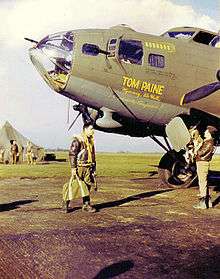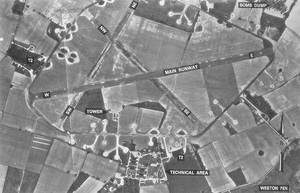RAF Knettishall
| Royal Air Force Station Knettishall USAAF Station 136 .png) | |
|---|---|
| Located Near Thetford, Suffolk, United Kingdom | |
|
Aerial Photo of Knettishall Airfield - 12 May 1951 | |
 RAF Knettishall Map showing the location of RAF Knettishall within Suffolk. | |
| Coordinates | 52°22′26″N 000°52′41″E / 52.37389°N 0.87806°E |
| Type | Military airfield |
| Code | KN |
| Site information | |
| Controlled by | United States Army Air Forces |
| Site history | |
| Built | 1942 |
| In use | 1943-1957 |
| Battles/wars |
European Theatre of World War II Air Offensive, Europe July 1942 - May 1945 |
| Garrison information | |
| Garrison | Eighth Air Force |
| Occupants | 388th Bombardment Group |
RAF Knettishall is a former World War II airfield in England. The field is located 6 miles SE of Thetford in Suffolk between the villages of Knettishall and Coney Weston, which lies to the south. This location is on the southern side of the Little Ouse Valley and bordering the area of heath and forest known as the Breckland.
Overview
Knettishall was built for United States Army Air Forces Eighth Air Force use during 1942/1943 by W. & C. French Ltd. It was a late-design, heavy bomber airfield to Class A specification, and had the standard fifty-yard-wide concrete runways, the main being 6,000 feet long and the two intersecting secondary runways of 4,200 feet each in length, with an encircling perimeter track. There were fifty hardstands, two T2-type hangars and full technical services. Mark II airfield lighting permitted night flying.
Accommodation – largely Nissen huts – was provided in some dozen dispersed sites to the south of the flying airfield in the village of Coney Weston. The bomb store was situated on the far side of the field in a wood near Knettishall village.
USAAF use
Knettishall was one of several stations in East Anglia which was associated with a single Eighth Air Force unit for the whole of its operational period. It was assigned USAAF designation Station 136.[1]
388th Bombardment Group (Heavy)
The airfield was opened on 10 June 1943 and was used by the USAAF 388th Bombardment Group (Heavy). The 388th arrived from Wendover AAF Utah and was assigned to the 45th Combat Bombardment Wing. Its group tail code was a "Square-H". Its operational squadrons were:
- 560th Bombardment Squadron
- 561st Bombardment Squadron
- 562d Bombardment Squadron
- 563d Bombardment Squadron
The group flew Boeing B-17 Flying Fortresses as part of the Eighth Air Force's strategic bombing campaign.

The 388th BG began combat operations on 17 July 1943 by attacking an aircraft factory in Amsterdam. The unit functioned primarily as a strategic bombardment organization until the war ended. Targets included industries, naval installations, oil storage plants, refineries, and communications centers in Germany, France, Poland, Belgium, Norway, Romania and the Netherlands.
The group received a Distinguished Unit Citation for withstanding heavy opposition to bomb a vital aircraft factory at Regensburg on 1 August 1943. The 388th received another DUC for three outstanding missions: an attack against a tire and rubber factory in Hanover on 26 July 1943; the bombardment of a synthetic oil refinery in Brüx on 12 May 1944; and a strike against a synthetic oil refinery at Ruhland on 21 June 1944, during a shuttle raid from England to the Soviet Union.
The unit attacked many other significant targets, including aircraft factories in Kassel, Reims, and Brunswick; airfields in Bordeaux, Paris, and Berlin; naval works at La Pallice, Emden, and Kiel; chemical industries in Ludwigshafen; ball-bearing plants in Schweinfurt; and marshalling yards in Brussels, Osnabrück, and Bielefeld. Operations also included support and interdictory missions. Helped prepare for the invasion of Normandy by attacking military installations in France, and on D-Day struck coastal guns, field batteries, and transportation. Continued to support ground forces during the campaign that followed, hitting such objectives as supply depots and troop concentrations. Bombed in support of ground forces at Saint-Lô in July 1944 and at Caen in August. Covered the airborne assault on the Netherlands in September 1944 by attacking military installations and airfields at Arnhem. Aided the final drive through Germany during the early months of 1945 by striking targets such as marshalling yards, rail bridges, and road junctions. Altogether the 388th flew 331 raids to European targets including nineteen Operation Aphrodite missions from nearby RAF Fersfield. After V-E Day, the group flew food to the Netherlands to relieve flood-stricken areas. The 388th returned to Sioux Falls AAF South Dakota and was inactivated on 28 August 1945.
Postwar military use
After the war, Knettishall was placed in the hands of a Royal Air Force holding group. Between 1946 and late 1948 it was used by the British Army as the base of the Depot Battalion, Royal Army Service Corps (RASC). The various sections were scattered about in the buildings of the airfield. The Depot Battalion was a transit organisation of the RASC for movements around the world. There was a permanent staff and always good cricket and football teams.
The station was declared surplus to requirements on 22 February 1957 and was sold.
Civil use
With the end of military control, the runways and many of the buildings were broken up or demolished in the late 1950s.
Today little is left of Knettishall airfield. A few single-lane farm roads are all that remains of the runways and taxiways, along with a handful of wartime buildings in various states of deterioration. An eight hundred metre grass airstrip has been constructed, adjacent to, and north of the line of the old east/west runway. Three small hangars house around six light aircraft. On a double loop hardstand to the west of the airfield three nissen-type huts and an old T-2 wartime hangar provides warehouse, storage and office space.
References
![]() This article incorporates public domain material from the Air Force Historical Research Agency website http://www.afhra.af.mil/.
This article incorporates public domain material from the Air Force Historical Research Agency website http://www.afhra.af.mil/.
Notes
- ↑ "Knettishall Airfield Station 136". Mighty 8th Cross-Reference. Retrieved 2008-02-06.
- ↑ "USAAF Serial Numbers (42-30032 to 42-39757)". Encyclopedia of American Aircraft. Joseph F. Baugher. Retrieved 2008-02-06.
- ↑ "Aircraft Index". 388th Bomb Group Database. Retrieved 2008-01-06.
Bibliography
- Freeman, Roger A. (1978) Airfields of the Eighth: Then and Now. After the Battle ISBN 0-900913-09-6
- Freeman, Roger A. (1991) The Mighty Eighth: The Colour Record. Cassell & Co. ISBN 0-304-35708-1
- Maurer, Maurer (1983). Air Force Combat Units Of World War II. Maxwell AFB, Alabama: Office of Air Force History. ISBN 0-89201-092-4.
- Ravenstein, Charles A. (1984). Air Force Combat Wings Lineage and Honors Histories 1947-1977. Maxwell AFB, Alabama: Office of Air Force History. ISBN 0-912799-12-9.
- Rogers, Brian (2005). United States Air Force Unit Designations Since 1978. Hinkley, England: Midland Publications. ISBN 1-85780-197-0.
- Singer, Richard L (2001) 388th Anthology: Tales of the 388th Bombardment Group 1942-45. ISBN 0-595-19551-2 (Vol I) ISBN 0-595-18758-7 (Vol II)
External links
| Wikimedia Commons has media related to RAF Knettishall. |
- 388th Bombardment Group Photographer's website
- Photographs and history
- RAF Knettishall at Airfields & Aviation Memorials
